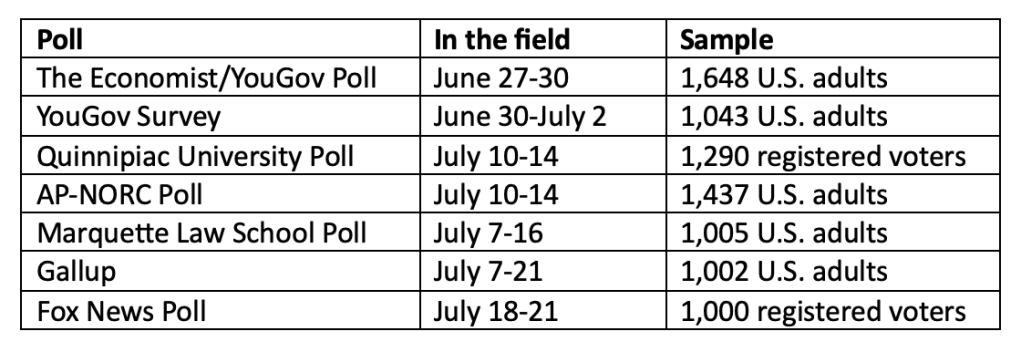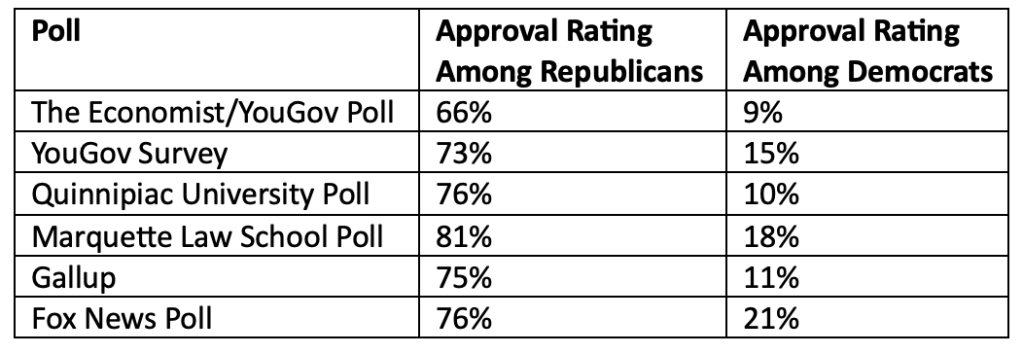The Supreme Court is historically unpopular right now. Or is it?


Is the Supreme Court’s approval rating at a five-year high or record low? It depends on which survey you’re reading.
In just the past two months, at least seven national polls on the court’s work have been fielded and released, leading to a confusing – and at times contradictory – mix of headlines about how the public views the justices.
The surveys reported not just different approval ratings, but different trend lines. Gallup found that Americans’ views of the Supreme Court are historically low, while a Fox News Poll showed that the court’s approval rating is higher today than it’s been since 2020.
The different results stemmed from a variety of factors, including differences in question wording and sample size. And when they reported on trends, survey firms were drawing on their own past findings, not other recent polls.

For those reasons and others, each of the seven surveys told a unique story about Americans’ views on the Supreme Court. But a few themes emerge if you read them all in a row. Here are four key takeaways from the seven surveys.
1. The Supreme Court’s approval rating is under 50%.
Six of the seven polls included a traditional approval rating question in which respondents were asked if they approve or disapprove of the justices’ job performance. (The poll from The Associated Press-NORC Center for Public Affairs Research was the exception.) And although the resulting approval rating varied from survey to survey, none of the six polls showed majority support for the Supreme Court:

In fact, in four of the six surveys, including the Gallup poll that, earlier this month, inspired multiple news articles about support for the court reaching a record low, the court’s approval rating was at least 10 percentage points below 50%, falling between 35% and 40%.
The gap between those four polls and the two that reported a slightly higher approval rating – the Marquette Law School Poll (49%) and the Fox News Poll (47%) – likely stemmed from differences in the question wording and response options.
While five of the six surveys, including Marquette’s, asked respondents to assess how the Supreme Court “is handling its job,” the Fox News Poll asked respondents how they feel about “the job the Supreme Court of the United States is doing.” Even a slight difference in question wording can lead to a different pattern in responses, according to Pew Research Center, which explains why survey firms typically build trend lines with responses over time to the exact same question, rather than responses to similar questions.
What made the Marquette Law School Poll unique is that participants had only two response options: “approve” or “disapprove.” The other polls included the option to express uncertainty or no opinion.
The Gallup and Fox News Poll survey reports were the only two to include a trend line showing how the court’s approval rating has changed over the past two decades. Both organizations say it hasn’t been above 50% since the summer of 2020, but they disagree on what direction it’s currently moving, with Fox News showing the court’s approval rating increasing and Gallup showing it decreasing.
That said, the Supreme Court still has a higher approval rating than Congress, according to the two polls that asked about Congress’ performance: the surveys from The Economist/YouGov (18%) and Gallup (26%). The four polls that asked about President Donald Trump’s job performance – Quinnipiac (40%), Fox News (46%), Gallup (37%), and The Economist/YouGov (42%) – found that his approval rating is about the same as the Supreme Court’s.
2. There is a partisan gap in Supreme Court approval.
All six of the polls that produced an overall approval rating also shared how responses from Republicans and Democrats differed. Republicans expressed far higher levels of support for the justices’ job performance in each poll, with the average partisan gap across the six polls being a massive 60.5 percentage points.

Republicans were also more positive than Democrats about the Supreme Court in the seventh poll, from AP-NORC. It found that 31% of Republicans have “a great deal” of confidence in the people running the Supreme Court, compared to just 5% of Democrats.
Similarly large partisan gaps were present in the responses to a variety of other questions included in the surveys. Republicans were more likely than Democrats to say the court has about the right amount of power (67% vs. 38%), that it’s mainly motivated by the law rather than politics (54% vs. 9%), and that it’s generally “about right” in its decisions (56% vs. 17%).
These results match historical trends in the sense that Republicans are typically happier with the Supreme Court than Democrats when there’s a Republican in the White House, according to Gallup. What’s unique about this political moment is that Republican support for the court was already higher than Democratic support during the second half of the Biden administration; the court’s approval rating from Republicans surged after its June 2022 decision overruling Roe v. Wade and the constitutional right to an abortion.
3. The Dobbs decision still looms large in Supreme Court polling.
Gallup reported that the June 2022 ruling in Dobbs v. Jackson Women’s Health Organization pushed court-related polarization to a new level. Five of the six largest partisan gaps in Supreme Court approval identified by Gallup over the past 25 years came in surveys fielded after the Dobbs decision was handed down. (The exception was a 58-percentage point gap measured in July 2015 after the Supreme Court legalized same-sex marriage. In that case, Democrats showed more support than Republicans.)
Gallup wasn’t the only survey firm or news site to mention the abortion ruling when reporting on new polling data. The Associated Press similarly noted that the “partisan divide has been persistent and stark” since Dobbs was decided.
That said, the court’s overall approval rating was already falling before June 2022, when the partisan gap notably expanded. Gallup’s trend line shows that the court’s approval rating dropped from 53% to 49% from August 2020 to July 2021, and Fox News’ chart shows a similar shift from July 2020 to June 2022. The downward trend over this period was driven by drops in support from both Republicans and Democrats, according to Gallup’s historical data. While Republican support for the court has surged since then, the approval rating from Democrats has made a similar move in the opposite direction, which is keeping the court’s overall approval rating below 50%.
Possible explanations for the approval rating drop from mid-2020 to mid-2022 include the COVID-19 pandemic, which led to several controversial decisions on vaccine mandates and church closures, and high-profile rulings on transgender workers, the Affordable Care Act, and faith-based adoption agencies (the first two rulings angered many Republicans, while the third angered many Democrats.) The Advisory Opinions podcast recently pointed to Justice Amy Coney Barrett’s confirmation in October 2020 as a possible source of the recent approval rating drop, noting that many people were frustrated that the Senate acted on her nomination so close to a presidential election after refusing to confirm Merrick Garland four years earlier.
4. Men are more likely to approve of the Supreme Court than women.
In addition to identifying a partisan gap in views on the Supreme Court, several of the polls identified a gender gap. The four survey reports that broke down approval ratings by gender found at least a five-percentage point gap between the ratings from men and women, with men having a higher approval rating of the court. The average gender gap across the four polls was 11.5 percentage points.

The Quinnipiac University Poll identified a similar gender gap in responses to its question about what motivates the Supreme Court. Seventy percent of women said it’s mainly motivated by politics, rather than the law, compared to 56% of men.
The Dobbs ruling may have caused or widened the gender gap, although that theory is not addressed in this summer’s survey reports. Previous research has shown that men were more supportive of the Dobbs ruling than women and that the gender gap in views on abortion has reached historic highs since the abortion decision was released.
Since a draft of the majority opinion leaked in May 2022, the share of women who identify as “pro-choice” or consider abortion to be “morally acceptable” has held steady, while the share of men who claim the label or hold that view has decreased, according to Gallup. And Pew found in July 2022 that 47% of women “strongly” disapproved of the Dobbs decision, compared to 37% of men.
Conclusion
Although the seven recent polls offered seven different takes on the Supreme Court’s popularity, it’s fair to conclude that fewer than half of Americans approve of the justices’ job performance and that Republicans (as well as men) hold much more positive feelings about the court than Democrats (and women).
It’s less clear what role the court’s 2022 abortion ruling played in these partisan and gender gaps, or where the court’s approval rating will go from here. Finding answers will require fielding even more surveys.
Posted in Court Analysis, Uncategorized
Cases: Dobbs v. Jackson Women’s Health Organization